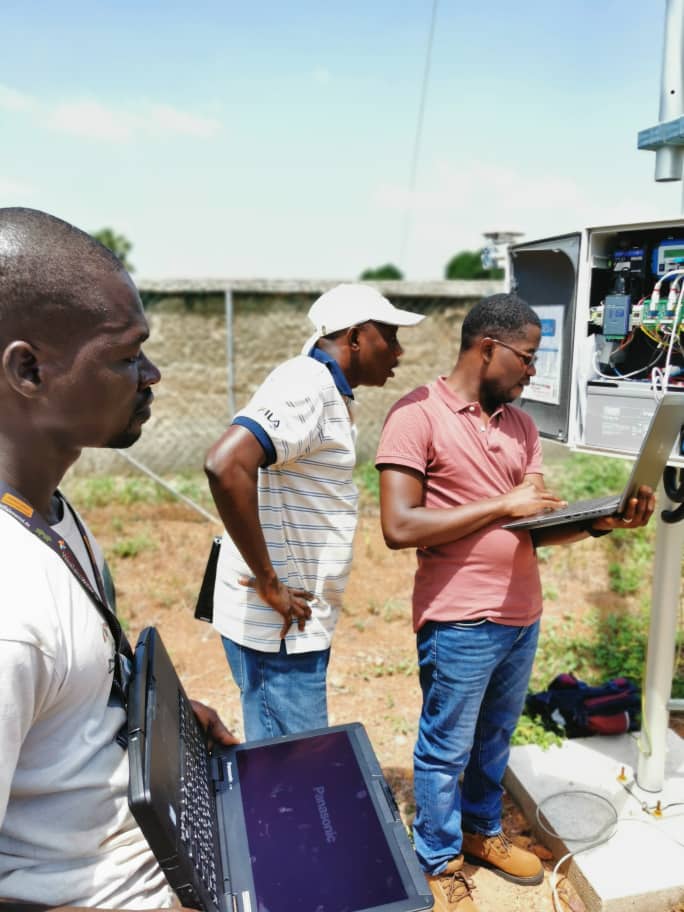Interview with Dr. Windmanadga Sawadogo from University of Augsburg. He talks about his recent trip to the EnerSHelF field sites and about processing the collected meteorological data.
You are working in WP 3.2, focusing on high-resolution meteorological forecasts for Ghana. Can you explain how your work contributes to the overall aim of the EnerSHelF project to improve and disseminate marketable PV-based energy solutions for health facilities in Ghana?
The work of the University Augsburg is to produce weather forecasts for the three pilot sites and to spread the data to different partners in the project. For this, I am working closely with Samer Chaaraoui from the University of Applied Sciences Bonn-Rhein-Sieg (H-BRS), as he needs the forecasting data to improve the accuracy of his models for photovoltaic-hybrid systems. Currently, we are at the stage where everything is ready, and we are running the forecasts for the three sites every day. The collected data are kept at our servers at the KIT campus at Garmisch-Partenkirchen while we are waiting for the FTP (File Transfer Protocol) from our partner WASCAL (West African Science Service Centre on Climate Change and Adapted Land Use) to upload the data so that everyone can easily access the data.
In October this year, you travelled to Ghana and Burkina Faso for the EnerSHelF project. What was the objective of your trip?
I was in Ghana from 4th to 10th October to do maintenance on three Automatic Weather Stations (AWS) that we had installed in Kologo, Kumasi, and Akwatia one year ago. Once a year, we must visit the stations to clean the sensors and check cables and the configuration. I was in Ghana for one week, but it was hectic as we had to travel a lot – all the way from the North to the South and back up again. It was particularly difficult because of Covid-19, as most borders are still closed and I had to first fly to Accra and then to Tamale, where a driver picked me up at the airport to drive me to Bolga. From there, we went to the Kologo health centre to check the first AWS. Afterwards we had to drive all the way to Kumasi and Akwatia by car. At the end, I flew back to Burkina Faso from Accra, so it was a real journey.
That sounds like a tight time schedule for one week! But you managed to maintain all the weather stations?
Yes, and additionally to that, we (Samuel Guug from WASCAL and I) managed to maintain the H-BRS equipment at Akwatia as well. For example, the cloud camera and the dust IQ as well as if all other measurement devices work as planned.
About one year ago, we published an article on the EnerSHelF website where you talked about the installation of the automatic weather stations already. Have those stations been successful in gathering the data you needed?
Yes, with the data we collected, we wanted to improve our weather forecast. Furthermore, it is possible to access the data when I am in Germany as there is a router inside the logger so that allows us to download the files. I also transfer the data to Mohammed Abass from our industry partner WestfalenWIND and to Samer Chaaraoui from H-BRS. Overall, we can use the data for the EnerSHelF project and for other purposes. In this regard, everything is working well.
How are you processing the data and what will be the final product of your work?
When we download the data, it is raw data which we must process as it is unreadable at first. The company where we bought the stations provided us with a guideline on how to decode it. For example, which column belongs to which parameters – like solar radiation, wind speed or rainfall as well as the date, the hour, the minutes, the seconds, and everything else contained in the files. By now, we have developed a pattern which allows me to automatically convert the unreadable data to readable ones. After that, we save it in the ASCII format and those files, I can send to other people as it is easy for them to read.
What are your next steps within the EnerSHelF project?
Overall, we want to write three papers. We have already submitted the paper for the WRF (Weather Research and Forecasting) configuration over Ghana. Currently, we are working on the second one which is on a comparison of different solar irradiance datasets from ERA5, MERRA, CAMS and SARAH with 48 automatic weather stations in hourly basic. Afterwards, the last paper will be on three days ahead forecast of solar irradiance on the 3 pilot sites with bias correction approach.
Interview by Jonas Bauhof
All pictures taken by Dr. Windmanagda Sawadogo






